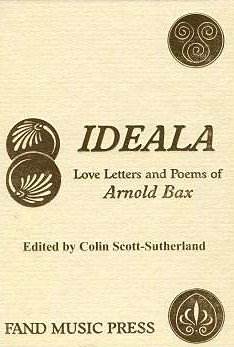What we have here are all the poems of Arnold Bax …
or at least all the ones known to Colin Scott-Sutherland, the editor,
who is also the first Bax scholar in modern times. The poems are as
written under Bax's own name as well as those published under the name
of his Irish 'doppelganger', Dermot O'Byrne. The editor has also in-gathered
a selection of the composer's teenage love letters.
Colin's dogged dedication to the Bax cause - sharing
Bax's creative work with the world - complements the now more celebrated
work of fellow Baxian, Lewis Foreman. Lewis's Bax biography published
in centenary year 1983, rather eclipsed Mr Scott-Sutherland's 'Arnold
Bax', published by Dent in 1973. The Dent book, in any event, was promptly
remaindered alongside other valuable music studies in the Dent catalogue
including Santeri Levas's Sibelius memoir and Myrrha Bantock's chatty
but engagingly flavoured life story of her father.
Pages 15 to 281 comprise the poems and letters. There
are eight appendices and an introduction by the editor. The book is
laid out in sections coinciding with the various collections and previously
unpublished sources:-
Poems in Red Notebook
First (typed) collection
Letter to Isobel Hodgson
Seafoam and Firelight
Letters to Mary Field
Second (typed) collection
Harriet Cohen and the Princess's Rose Garden
Elsa Sobrino
Verses - third typed collection
Love Poems of a Musician
A Dublin Ballad and Other Poems
Memoir 'The Two Brothers' (Francis Colmer)
There are two indices. The first keys the poems by
title (it is notable that Bax gave titles to all the poems here). The
second is a general index to people, works, places and events. This
will be valuable to Bax enthusiasts and scholars.
There are some 280 poems collected together for the
first time. It is not the first collection. For that we need to go back
to a classically slim volume from Thames in which 90 or so of the poems
were published under the editorship of Lewis Foreman. Each poem in Ideala
is carefully footnoted to explain obscure references. Alternative versions
are also recorded with variorum diligence.
The book lacks a dust jacket and this may be a material
drawback in years to come especially if heavily used. It is very solidly
case bound in bleached cream boards inlaid with gold stamped titling
and using rondel designs from an early edition of Swinburne's 'Atalanta
in Calydon' (itself a poem set as a symphony for voices alone by Bax's
yet more neglected contemporary, Granville Bantock).
We must not forget that the letters and poems are the
product of an artist between the ages of year 1904 to 1916. Where published
at all their presentation to the general public was long delayed.
There are plentiful photographs and other plates. Some
of these appear for the first time including a 1920 photo of Mary Gleaves
(whom Bax met in 1926). This reveals a face of witchery and an elfin
bone structure. We take away some insight into what it was that drew
Bax to her.
Bax's revelling in youthful amours helped him through
his forties and fifties. He strove some would say rather pathetically
to keep in touch with the dangerously delicious spirit that lit his
privileged youth and which fed his music. When even that burned to ash
his music too lost its wayward conviction, its dangerous imagery and
its Hy Brasil enchantment. His last poems date from the end of the Great
War written at the age of 25. By the time another 25 years had passed
he had completed his Seven Symphonies and the works that followed evince
hardly a sign of the flame-chased conviction that burned in his greatest
music. A more ruthless verdict would draw the line not at 1945 but at
1935.
Bax's literary efforts are youthful. This was a youth
to which Bax bade a regretful, anxious and not very convincing farewell.
It was across these ravines, over these cliffs, touching these yielding
hills, that Bax developed as a man. His youth shackled him but at the
same time liberated from him music unique in the world's art. Without
his infatuation with youth and without the pain of its trickling and
then accelerating loss his music would have been less than it is.
Bax's verse, even his sparer style of the later years,
is not for those who crave the instant gratification incited by the
present day. It requires time. I wonder if it will appeal to the poetry
press. I am intrigued to see how the book is received in those quarters.
For Baxians and even for those who have just been caught up by a chance
hearing of a Bax work this poetry, refulgent, pained, ecstatic, sensuous,
will add volume, mass and dimension to the listening experience. I wonder
how long it will be before these poems are used as an oration to one
of Bax's works.
The poems offer evidence of Bax's psychological landscape.
That evidence is probably even more valuable than his letters though
possibly harder to interpret. In verse the emotional language of youth
(at least of Bax's generation) is most likely to have been freed to
express itself.
I do not underestimate the dedication invested in this
work by the editor and the publisher. It must have been a phenomenal
task and it is the fate of such dedication that it will almost certainly
see other Bax poems emerging from private collections. It is intriguing
to think that further poems may yet be found amongst the Harriet Cohen
papers which came into the public domain last year.
This is a prominent landmark in the Bax literature
and another magus-key to one window into Bax's musical legacy: a magic
casement indeed.
Rob Barnett
ORDER FROM
Fand Music Press
The Barony
16 Sandringham Road
Oetersfield
Hampshire GU 32 2AA
United Kingdom
Phone / Fax: ++44 (0)1730 267341
www.fandmusic.com
contact@fandmusic.com

